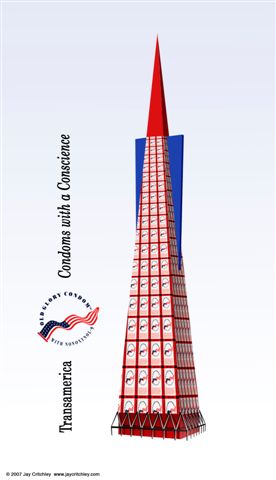Remember when Jay Critchley was blowin’ in the wind with his proposal for “Martucket Eyeland,” a Disneyfied Vegas-style Resort & Theme Park in Nantucket Sound? It was designed to help scuttle the plan for an offshore wind farm of 130 giant wind turbines, each taller than the Statue of Liberty, to stretch across roughly 25 square miles of the Sound from Cape Cod to Martha’s Vineyard and Nantucket. And scuttled it was. Or so it was thought. Well, a year later the wind farm is back.
 So is Critchley. Only this time he’s up to no good with a new twist on an old project: “TransAmerica — Condoms with a Conscience.” It’s part of an exhibition, Corporate Art Expo ’07, at THE LAB in San Francisco featuring artists who, in the curator’s words, “package themselves as corporate entities” with “whimsical” (read: subversive) agendas.
So is Critchley. Only this time he’s up to no good with a new twist on an old project: “TransAmerica — Condoms with a Conscience.” It’s part of an exhibition, Corporate Art Expo ’07, at THE LAB in San Francisco featuring artists who, in the curator’s words, “package themselves as corporate entities” with “whimsical” (read: subversive) agendas.
The exhibition includes Critchley’s 3-foot scale model of the TransAmerica Building made out of condom boxes with the logo of his patriotically named Old Glory Condoms Corporation on them. The condoms are imprinted with an American flag. Company motto: Worn with pride country-wide.
Critchley says he wants “to initiate a public dialogue on the role of global corporations in the fight against HIV/AIDS.”
As Shane Montgomery, who curated the show, puts it (in corporate-style artspeak, naturally):
Over the last few years, a new group of artists have emerged that package themselves as corporate entities. They develop a company name, a branding
scheme, and utilize the language of advertising and marketing. These individual artists and collectives create art objects, marketing materials, and performative event-based pieces that can exist in a gallery setting as well as in the public sphere. Much of this work centers around issues of capitalism and consumerism. By putting this work within the context of fictional products or alternative services, we are able to engage in a more enhanced conversation around topics ranging from globalization, immigration reform, and health care in a way that is whimsical and visually inspiring.
Other artists in the show include the Anti-Advertising Agency, Acclair, C5 Corporation, Davis & Davis Research, Meaning Maker, My Death and Taxes, PP Valise, SubRosa, Slop Art, TDirt, Tectonic Corporation, and We Are War. Among the products on exhibit are “psychological prosthetics, self-help services, psycho-geographic mapping, research and development services, neurotransmitter security services, safety educational materials, and product placement services.”
Sidebar
 “Old Glory was launched in 1989 at MIT List Visual Arts Center,” Critchley writes in a press release. “[It was] inspired by Bush I and the US Congress’ attempt to amend the Constitution to ban flag desecration, and the invisibility of HIV/AIDS in the government. Although I had often utilized the corporate structure to create a media platform for ideas and interventions, Old Glory was the real thing — shareholders and marketable products.”
“Old Glory was launched in 1989 at MIT List Visual Arts Center,” Critchley writes in a press release. “[It was] inspired by Bush I and the US Congress’ attempt to amend the Constitution to ban flag desecration, and the invisibility of HIV/AIDS in the government. Although I had often utilized the corporate structure to create a media platform for ideas and interventions, Old Glory was the real thing — shareholders and marketable products.”
He continues:
My strategy was to challenge the government’s silence and redefine patriotism — it’s patriotic to protect and save lives. My US Trademark application was rejected as “immoral and scandalous to associate the flag with sex,” but the Center for Constitutional Rights’ lawyer, David Cole, represented me pro bono, and we won a three-year legal battle.
As a business, it was less successful because the FDA did not approve multi-colored condoms − over concern for the effect of inks on latex. Our successful Latex is 4 Lovers campaign brought attention to lambskin condoms’ ineffective prevention of HIV transmission. Senator Jesse Helms, ironically, created the first global safer sex ad, holding up the Old Glory logo in the Senate on CNN, denouncing the trademark designation. Old Glory is now in standard law school textbooks on trademark, copyright and patent law. Long May It Wave.
Hail to the condom.
